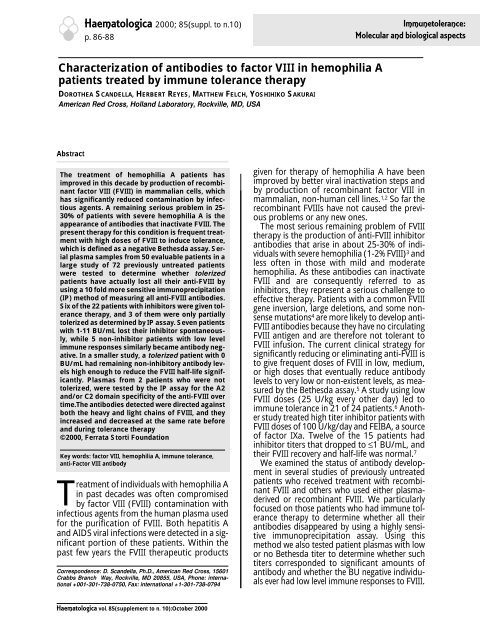Haematologica 2000;85:supplement to no. 10 - Supplements ...
Haematologica 2000;85:supplement to no. 10 - Supplements ...
Haematologica 2000;85:supplement to no. 10 - Supplements ...
Create successful ePaper yourself
Turn your PDF publications into a flip-book with our unique Google optimized e-Paper software.
<strong>Haema<strong>to</strong>logica</strong> <strong>2000</strong>; <strong>85</strong>(suppl. <strong>to</strong> n.<strong>10</strong>)<br />
p. 86-88<br />
Immune<strong>to</strong>lerance:<br />
Molecular and biological aspects<br />
Characterization of antibodies <strong>to</strong> fac<strong>to</strong>r VIII in hemophilia A<br />
patients treated by immune <strong>to</strong>lerance therapy<br />
DOROTHEA SCANDELLA, HERBERT REYES, MATTHEW FELCH, YOSHIHIKO SAKURAI<br />
American Red Cross, Holland Labora<strong>to</strong>ry, Rockville, MD, USA<br />
Abstract<br />
The treatment of hemophilia A patients has<br />
improved in this decade by production of recombinant<br />
fac<strong>to</strong>r VIII (FVIII) in mammalian cells, which<br />
has significantly reduced contamination by infectious<br />
agents. A remaining serious problem in 25-<br />
30% of patients with severe hemophilia A is the<br />
appearance of antibodies that inactivate FVIII. The<br />
present therapy for this condition is frequent treatment<br />
with high doses of FVIII <strong>to</strong> induce <strong>to</strong>lerance,<br />
which is defined as a negative Bethesda assay. Serial<br />
plasma samples from 50 evaluable patients in a<br />
large study of 72 previously untreated patients<br />
were tested <strong>to</strong> determine whether <strong>to</strong>lerized<br />
patients have actually lost all their anti-FVIII by<br />
using a <strong>10</strong> fold more sensitive immu<strong>no</strong>precipitation<br />
(IP) method of measuring all anti-FVIII antibodies.<br />
Six of the 22 patients with inhibi<strong>to</strong>rs were given <strong>to</strong>lerance<br />
therapy, and 3 of them were only partially<br />
<strong>to</strong>lerized as determined by IP assay. Seven patients<br />
with 1-11 BU/mL lost their inhibi<strong>to</strong>r spontaneously,<br />
while 5 <strong>no</strong>n-inhibi<strong>to</strong>r patients with low level<br />
immune responses similarly became antibody negative.<br />
In a smaller study, a <strong>to</strong>lerized patient with 0<br />
BU/mL had remaining <strong>no</strong>n-inhibi<strong>to</strong>ry antibody levels<br />
high e<strong>no</strong>ugh <strong>to</strong> reduce the FVIII half-life significantly.<br />
Plasmas from 2 patients who were <strong>no</strong>t<br />
<strong>to</strong>lerized, were tested by the IP assay for the A2<br />
and/or C2 domain specificity of the anti-FVIII over<br />
time.The antibodies detected were directed against<br />
both the heavy and light chains of FVIII, and they<br />
increased and decreased at the same rate before<br />
and during <strong>to</strong>lerance therapy<br />
©<strong>2000</strong>, Ferrata S<strong>to</strong>rti Foundation<br />
Key words: fac<strong>to</strong>r VIII, hemophilia A, immune <strong>to</strong>lerance,<br />
anti-Fac<strong>to</strong>r VIII antibody<br />
Treatment of individuals with hemophilia A<br />
in past decades was often compromised<br />
by fac<strong>to</strong>r VIII (FVIII) contamination with<br />
infectious agents from the human plasma used<br />
for the purification of FVIII. Both hepatitis A<br />
and AIDS viral infections were detected in a significant<br />
portion of these patients. Within the<br />
past few years the FVIII therapeutic products<br />
Correspondence: D. Scandella, Ph.D., American Red Cross, 15601<br />
Crabbs Branch Way, Rockville, MD 20<strong>85</strong>5, USA, Phone: international<br />
+001-301-738-0750, Fax: international +1-301-738-0794<br />
given for therapy of hemophilia A have been<br />
improved by better viral inactivation steps and<br />
by production of recombinant fac<strong>to</strong>r VIII in<br />
mammalian, <strong>no</strong>n-human cell lines. 1,2 So far the<br />
recombinant FVIIIs have <strong>no</strong>t caused the previous<br />
problems or any new ones.<br />
The most serious remaining problem of FVIII<br />
therapy is the production of anti-FVIII inhibi<strong>to</strong>r<br />
antibodies that arise in about 25-30% of individuals<br />
with severe hemophilia (1-2% FVIII) 3 and<br />
less often in those with mild and moderate<br />
hemophilia. As these antibodies can inactivate<br />
FVIII and are consequently referred <strong>to</strong> as<br />
inhibi<strong>to</strong>rs, they represent a serious challenge <strong>to</strong><br />
effective therapy. Patients with a common FVIII<br />
gene inversion, large deletions, and some <strong>no</strong>nsense<br />
mutations 4 are more likely <strong>to</strong> develop anti-<br />
FVIII antibodies because they have <strong>no</strong> circulating<br />
FVIII antigen and are therefore <strong>no</strong>t <strong>to</strong>lerant <strong>to</strong><br />
FVIII infusion. The current clinical strategy for<br />
significantly reducing or eliminating anti-FVIII is<br />
<strong>to</strong> give frequent doses of FVIII in low, medium,<br />
or high doses that eventually reduce antibody<br />
levels <strong>to</strong> very low or <strong>no</strong>n-existent levels, as measured<br />
by the Bethesda assay. 5 A study using low<br />
FVIII doses (25 U/kg every other day) led <strong>to</strong><br />
immune <strong>to</strong>lerance in 21 of 24 patients. 6 A<strong>no</strong>ther<br />
study treated high titer inhibi<strong>to</strong>r patients with<br />
FVIII doses of <strong>10</strong>0 U/kg/day and FEIBA, a source<br />
of fac<strong>to</strong>r IXa. Twelve of the 15 patients had<br />
inhibi<strong>to</strong>r titers that dropped <strong>to</strong> ≤1 BU/mL, and<br />
their FVIII recovery and half-life was <strong>no</strong>rmal. 7<br />
We examined the status of antibody development<br />
in several studies of previously untreated<br />
patients who received treatment with recombinant<br />
FVIII and others who used either plasmaderived<br />
or recombinant FVIII. We particularly<br />
focused on those patients who had immune <strong>to</strong>lerance<br />
therapy <strong>to</strong> determine whether all their<br />
antibodies disappeared by using a highly sensitive<br />
immu<strong>no</strong>precipitation assay. Using this<br />
method we also tested patient plasmas with low<br />
or <strong>no</strong> Bethesda titer <strong>to</strong> determine whether such<br />
titers corresponded <strong>to</strong> significant amounts of<br />
antibody and whether the BU negative individuals<br />
ever had low level immune responses <strong>to</strong> FVIII.<br />
<strong>Haema<strong>to</strong>logica</strong> vol. <strong>85</strong>(<strong>supplement</strong> <strong>to</strong> n. <strong>10</strong>):Oc<strong>to</strong>ber <strong>2000</strong>
















